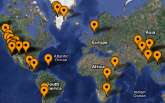About the EPIC

The EarthScope Primary Instrument Center (EPIC, formerly The IRIS PASSCAL Instrument Center) at New Mexico Tech supports cutting-edge geophysical research in Earth system science. The primary mission of the EPIC is to support the U.S. National Science Foundation’s (NSF) Geodetic- and Seismological- Facilities for the Advancement of Geoscience (GAGE and SAGE, respectively) and includes the support of portable/Principle Investigator-led instrumentation experiments as well as supporting several geophysical network operations centers. The GAGE and SAGE facilities are operated by EarthScope Consortium under a cooperative agreement with the NSF.
GAGE and SAGE provide instrumentation for NSF granted and other funded researchers (either from other US government agencies or independently funded) who require the use of instrumentation, engineering, logistics, data archiving, training and field installations and other resources to make their observations. Equipment is available to any research or educational institution to use for research purposes within the guidelines of established policies. These policies provide that data collected with GAGE or SAGE equipment be archived by EarthScope and be made openly available to the entire community. SAGE Instruments can be requested online using the Instrument Request Forms while GAGE instruments are available using the Project Support Request form.
In addition, the EPIC supports geophysical network operations in global and regional scientific networks, including the Network of the Americas (NOTA), Global Seismographic Network (GSN), Global GNSS Network (GGN), Borehole strainmeter network (BSM), and polar network operations funded by the NSF Office of Polar Programs (OPP). Specialized engineering design information and details on the instrumentation are openly shared and available to the research community.
- Home
- General Information
- Instrumentation
- Dataloggers
- Sensors
- All-In-One Systems
- Power Systems
- Field Procedures
- Controlled Sources
- Seismic Source Facility
- Magnetotelluric Systems at PASSCAL
- Ground Penetrating Radar
- Power and Memory Calculations Form
- Data Archiving
- Apply for a PI Account
- Experiment Scheduling
- Polar
- Important Hardware/Software Notes
- USArray
- Software


